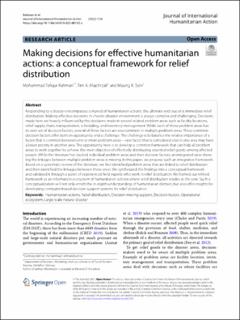| dc.contributor.author | Rahman, Mohammad Tafiqur | |
| dc.contributor.author | Majchrzak, Tim A. | |
| dc.contributor.author | Sein, Maung Kyaw | |
| dc.date.accessioned | 2023-08-25T13:37:42Z | |
| dc.date.available | 2023-08-25T13:37:42Z | |
| dc.date.created | 2023-01-11T10:35:28Z | |
| dc.date.issued | 2022 | |
| dc.identifier.citation | Rahman, M. T., Majchrzak, T. A. & Sein, M. K. (2022). Making decisions for effective humanitarian actions: a conceptual framework for relief distribution. Journal of International Humanitarian Action, 7, Artikkel 24. | en_US |
| dc.identifier.issn | 2364-3412 | |
| dc.identifier.uri | https://hdl.handle.net/11250/3085845 | |
| dc.description.abstract | Responding to a disaster encompasses a myriad of humanitarian actions; the ultimate and crucial is immediate relief distribution. Making effective decisions in chaotic disaster environment is always complex and challenging. Decisions made here are heavily influenced by the decisions made in several related problem areas such as facility locations, relief supply chain, transportation, scheduling, and inventory management. While each of these problem areas has its own set of decision factors, several of these factors are also common in multiple problem areas. These common decision factors offer both an opportunity and a challenge. The challenge is to balance the relative importance of a factor that is common between one or more problem areas—one factor that is considered vital in one area may have a lower priority in another area. The opportunity here is to develop a common framework that can help all problem areas to work together to achieve the main objective of effectively distributing essential relief goods among affected people. While the literature has studied individual problem areas and their decision factors, an integrated view showing the linkages between multiple problem areas is missing. In this paper, we propose such an integrative framework. Based on a systematic review of the literature, we first identified problem areas that are linked to relief distribution and then identified the linkages between these areas. We synthesized the findings into a conceptual framework and validated it through a panel of experienced field experts who work in relief distribution. We framed our refined framework as an information ecosystem of humanitarian actions where relief distribution resides at the core. Such a conceptualization will not only enrich the in-depth understanding of humanitarian domain, but also offer insights for developing computer-based decision support systems for relief distribution. | en_US |
| dc.language.iso | eng | en_US |
| dc.rights | Navngivelse 4.0 Internasjonal | * |
| dc.rights.uri | http://creativecommons.org/licenses/by/4.0/deed.no | * |
| dc.title | Making decisions for effective humanitarian actions: a conceptual framework for relief distribution | en_US |
| dc.type | Peer reviewed | en_US |
| dc.type | Journal article | en_US |
| dc.description.version | publishedVersion | en_US |
| dc.rights.holder | © The Author(s) 2022. | en_US |
| dc.source.pagenumber | 1-15 | en_US |
| dc.source.volume | 7 | en_US |
| dc.source.journal | Journal of International Humanitarian Action | en_US |
| dc.identifier.doi | https://doi.org/10.1186/s41018-022-00132-z | |
| dc.identifier.cristin | 2104738 | |
| dc.source.articlenumber | 24 | en_US |
| cristin.ispublished | true | |
| cristin.fulltext | original | |
| cristin.qualitycode | 1 | |

